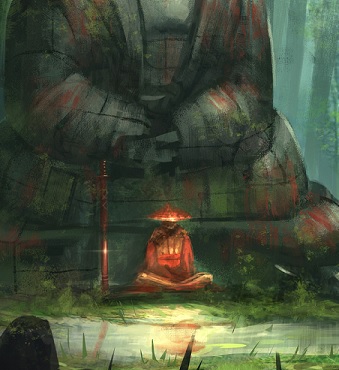Atmanudra
Language of the Soul
"The universe is fundamentally composed of dozens of elements, each of which gives form to our surroundings. Their differences are innumerable and vast, yet all share one commonality: all are material manifestations of the primordial energy, from which reality springs forth. Humanity is no different. It is through rigid self-control and spiritual purging that a person becomes able to manipulate one's own prana and the prana around them. The process and documentation of manipulating the immaterial energies is known as Atmanudra."
- The Elementarium, Chapter 3
Manifestation
Any "spell" is made up of at least three basic components: An Element, or form; Prana, or energy; and yama, or guided action. Energy is collected throughout the body utilizing special breathing techniques, and this energy is focused into one of the body's six Chakras to amplify it. With yama, the energy is expelled from the physical form and controlled by the user as an extension of themselves, interacting with The Elements around it and changing its form from one into another.
Prana and yama are vital to this process - without specific movements, the channels that one's Prana become muddied and blocked, disrupting the expulsion of energy necessary to effect the world. Without controlled breathing, one's energy is never properly formed within, and yama is wasted in ignorance. Finally, without form, the energy of the self flounders in this material existence and dissipates into the cosmos to return to The Godhead.
Linguistics
Atmanudra literally means "Self-position" and is a term used to describe both the philosophy regarding and the application of one's own spiritual energies. A person positions their mind, soul, and body to harmonize with the universal Kaprana and, for a brief moment, extend their will to it. The gestures that a magi makes to harness their energy are consistent across practitioners - every witch casts the same hex with the exact same movements, regardless of time, location, or even potency. Due to the rigidity of this system, a strange language arose out of communicative necessity: Atmanudra is glyphically based.
When written, the gestures of spellcasting are rendered as symbols - the most fundamental glyph is an X, the shape of the human body. It is from this shape that all other glyphs stem. Various accents are then positioned around the glyph to highlight the Chakras where one's Prana must be focused. The shape and accents then shift in sequence, illustrating exactly how one must move and breathe in order to replicate a spell. These sequences are known as Āsanas, and they form the "words" of Atmanudra. The Āsanas are written vertically and read up to down, and collections of Āsanas are depicted in groups from left to right, known as Āsanahitas.
Over decades and centuries, shorthand, sound change, and transliteration resulted in several distinct written interpretations and symbolic extrapolations of the Āsanahitas, but as they are all derived from natural laws, they share fundamental similarities which classify them all as the same "language". They can be grouped into three broad, yet distinct categories:
- Mulazabda: The original mystic language from which all others derive. Its symbology is the most simplistic and is characterized by its vast capacity for interpretation and visual clarity. It was designed by the Divine Bureaucracy to be easily interpreted across disparate cultures and languages, even potentially illiterate ones. In the current era, it is the least common type of Atmanudra seen, as many of its derivatives fall into one of the other two categories.
- Caru-Rasana: Once the Zamzian Empire reached its second golden age during 359 AC, the sanctioned study of the arcane was at unprecedented levels. Across all Zamzara, magic-users and their affiliates began distribution of spellbooks on a commercial level, eventually evolving into a more "presentable" and protracted dialect. This form persisted until the rise of the third dynasty around 1471 AC.
- Asatyasan: What went down in history as the "liar's mouth" was pushed by the Suuldar Dynasty as the true rendering of the natural laws as dreamed by The Godhead. They deliberately strove to be as distinct from previous Atmanudra as possible, and is characterized by its formalistic style - a result of its focus on ritualistic applications and overall divergence from the glyphic style. Most notably, it shares the most similarities with spoken languages, as it had thousands of words which translated to collections of Āsanahitas, allowing for rapid transmission of complex ideas.
Type
Metaphysical, Supernatural
Metaphysical, Supernatural
Remove these ads. Join the Worldbuilders Guild




Comments